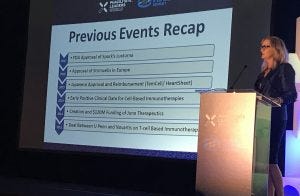
M&A, global partnerships and product approvals have all propelled regenerative medicines into the public discourse. We present the breakthroughs of 2018 and look at where the sector will head in 2019.
The “new frontier of medicine” arrived in the US in 2017 through the approval of chimeric antigen receptor (CAR) T-Cell therapies Kymriah (tisagenlecleucel) and Yescarta (axicabtagene ciloleucel), and gene therapy Luxturna (voretigene neparvovec).
But it was last year, 2018, which delivered the true potential of this burgeoning sector into the mainstream, Susan Nichols, CEO of cell therapy firm Falcon Therapeutics said at the recent Phacilitate conference in Miami, Florida.
10) End of the CRISPR patent war
Nichols described the CRISPR/Cas9 technology as “the cornerstone of gene editing,” and its use is, and will be, integral in many advanced therapies. However, up until late last year, the Broad Instute of MIT and University of California, Berkeley (UCB) were embroiled in a legal battle as to which organization owned the rights.

Regenerative medicines made leaps and strides in 2018. Image: iStock/vladru
Both claimed original development and full license of the technology, but in September 2018 this was settled with a US federal court ruling that the Broad Institute’s patents concerning CRISPR editing of eukaryotic genomes do not interfere with patent claims filed by UCB. Meanwhile, the European Patent Office (EPO) ruled in favor of UCB’s patents. While appeals are ongoing, the clarity has opened the door to increased use of CRISPR in developing new medicines.
9) Largest dedicated manufacturing facility opens
Lonza began production at its 300,000 square-foot facility in Houston, Texas, in April. Commissioned in 2015, the largest dedicated cell and gene therapy manufacturing facility in the world represents a shift in the inhouse vs outsourcing manufacturing model for advanced therapies, with Nichols saying she expects increased numbers of contract manufacturing organizations (CMOs) to move into the space.
8) CAR T-cell therapy pioneer recognized by Time magazine
Carl June, professor in Immunotherapy in the department of Pathology and Laboratory Medicine at University of Pennsylvania, was named in 2018’s Time 100, an annual list of the 100 most influential people in the world as compiled by Time Magazine.
His pioneering research in developing CAR T-cell therapies helped lead to the approval of Kymriah in August 2017. His admission article was written by Emily Whitehead, the first pediatric patient to be successfully cured by the then experimental therapy. The entry marks the recognition by the mainstream of the importance of these therapies.
7) US FDA report balancing safety and innovation in NEJM
A special report by commissioner Scott Gottlieb and director of the Center for Biologics Evaluation and Research (CBER) Peter Marks was published in March in the New England Journal of Medicine, addressing the expanded use of stem cell-based products and placing this into a growing regulatory framework. The article, which can be found here, demonstrates the regulator’s determination to aid the development of regenerative medicine, said Nichols.
6) Rise of China
Despite the threat of trade wars, there were a number of deals in the regenerative medicine space in China last year. This represents another milestone in the sector, demonstrating the global appeal of such therapies plus the opening up of what is likely to become the world’s largest market.

Susan Nichols, CEO of cell therapy firm Falcon Therapeutics
Nichols cited examples including Gilead/Kite’s joint venture with Fosun Pharma, Novartis’s partnership and investment in Shanghai-based Cellular Biomedicine Group (CBMG), and Athersys’ collaboration with Healios.
5) CRISPR babies
Staying with China, Nichols noted Chinese scientist Dr He Jiankui’s claim to have created and implanted the first genetically modified embryos resistant to the HIV virus. Despite the ethical questions such research raises, it highlights to a wider audience how powerful gene editing is and brings the sector into the forefront of public discourse.
4) Takeda’s $62 billion acquisition of Shire
The biggest acquisition in 2018 saw Japan’s Takeda acquire Shire. The deal brings Takeda into Pharma’s top 10, but from a cell and gene perspective adds “lucrative rare diseases therapies in Shire’s pipeline,” said Nichols. It also demonstrates the willingness to take advanced therapies into account when it comes to megamergers.
3) Moderna’s $604 million IPO
Sticking with business, the raising of $604 million in its initial public offering (IPO) broke records, said Nichols. The offering was larger than expected and valued the firm at $7.4 billion, once again showing the financial interest in new therapies, in this case messenger RNA (mRNA). The firm has 21 mRNA-based candidates in the pipeline and 10 in clinical trials.
2) Alofisel approval
So approvals still make news, and Nichols placed the European thumbs up for TiGenix’s Alofisel (darvadstrocel) as a major milestone, being the first allogeneic stem cell product to reach commercialization in a Western market. Allogeneic, or off-the-shelf, cell therapies represent an opportunity to treat more patients and reduce the high costs of manufacturing advanced therapies, currently a major issue in the space.

All about the money? Discourse has begun about how to pay for these new therapies
TiGenix has since been acquired by Takeda for $630 million.
1) Reimbursement conversations take center stage
While regulatory, business and product development milestones all shook the cell and gene therapy space in 2018, Nichols viewed the debate over pricing to be the biggest paradigm shift in the sector and said this will be the talking point for 2019.
With the FDA receiving over 800 INDs for proposed regenerative medicines to date and predicting this to increase by more than 200 each year from 2020, such products are on the edge of becoming a normal part of the healthcare landscape. As such, questions have arisen as to how to fund them.
Kymriah launched at $475,000 for a one-time cure, but the next generation of cell and gene therapies could have prices 10 times as much. AveXis’ Zolgensma (onasemnogene abeparvovec), for example, could have a price in the range of $4 million to $5 million per patient if commercialized.
Nichols praised the discourse underway as to how to fund these medicines in both the short and long-term, whether through a backstop, help from the capital markets, or a risk pool from insurers, and said “everyone is happy to engage in this conversation.”
About the Author
You May Also Like

schedl_b_and_w.jpg?width=100&auto=webp&quality=80&disable=upscale)
schedl_b_and_w.jpg?width=400&auto=webp&quality=80&disable=upscale)



